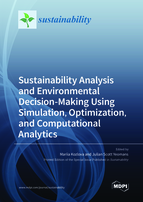Sustainability Analysis and Environmental Decision-Making Using Simulation, Optimization, and Computational Analytics
A special issue of Sustainability (ISSN 2071-1050).
Deadline for manuscript submissions: closed (30 November 2021) | Viewed by 33128
Special Issue Editors
Interests: environmental informatics; simulation decomposition; simulation-optimization; machine learning; visual analytics; waste management
Special Issues, Collections and Topics in MDPI journals
Special Issue Information
Dear Colleagues,
This Special Issue seeks applied computational analytics papers that either create new methods or provide innovative applications of existing methods to assist with sustainability analysis and environmental decision-making applications. In practice, environmental analytics is an integration of science, methods, and techniques that involves a combination of computers, computational intelligence, information technology, mathematical modelling, and system science to assess real-world, sustainability, and environmental problems. Contributions to this Special Issue should investigate novel approaches of computational analytics—be it on the side of modelling, computational solution procedures, optimization, simulation, and/or technologies—as applied to sustainability analysis and environmental decision-making. In line with the aims and scope of the Special Issue, manuscripts should emphasize both the practical relevance and the methodological contributions of the work to environmental decision-making and sustainability analysis.
Topics can include:
- Applied computational and visual analytics procedures;
- Simulation, optimization, and metaheuristic approaches used for environmental decision support;
- Machine learning, information technology, and expert systems for environmental applications;
- Methods for guidance and assistance in environmental decision-making;
- Measures for coping with uncertainty in data, models, and decision-making;
- Multicriteria decision making;
- Areas of application can include all areas of environmental decision-making and sustainability, such as waste, water, energy, climate change, industrial ecology, resource recovery, and recycling.
Prof. Dr. Julian Scott Yeomans
Dr. Mariia Kozlova
Guest Editors
Manuscript Submission Information
Manuscripts should be submitted online at www.mdpi.com by registering and logging in to this website. Once you are registered, click here to go to the submission form. Manuscripts can be submitted until the deadline. All submissions that pass pre-check are peer-reviewed. Accepted papers will be published continuously in the journal (as soon as accepted) and will be listed together on the special issue website. Research articles, review articles as well as short communications are invited. For planned papers, a title and short abstract (about 100 words) can be sent to the Editorial Office for announcement on this website.
Submitted manuscripts should not have been published previously, nor be under consideration for publication elsewhere (except conference proceedings papers). All manuscripts are thoroughly refereed through a single-blind peer-review process. A guide for authors and other relevant information for submission of manuscripts is available on the Instructions for Authors page. Sustainability is an international peer-reviewed open access semimonthly journal published by MDPI.
Please visit the Instructions for Authors page before submitting a manuscript. The Article Processing Charge (APC) for publication in this open access journal is 2400 CHF (Swiss Francs). Submitted papers should be well formatted and use good English. Authors may use MDPI's English editing service prior to publication or during author revisions.
Keywords
- environmental decision-making
- simulation
- optimization
- computational analytics
- visual analytics
- sustainability
- analysis
- waste management
- water resource planning
- energy
- climate change
- industrial ecology
- resource recovery
- recycling







